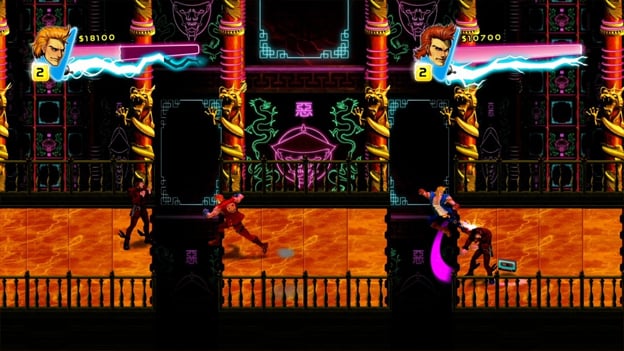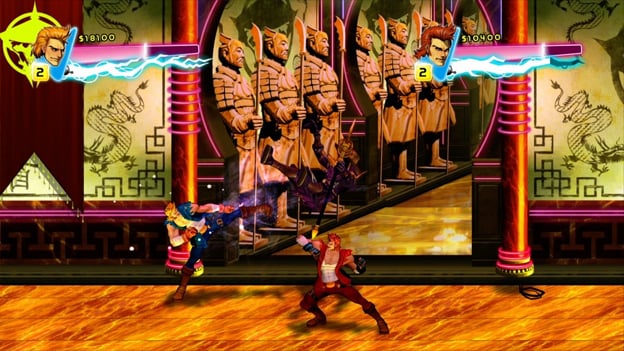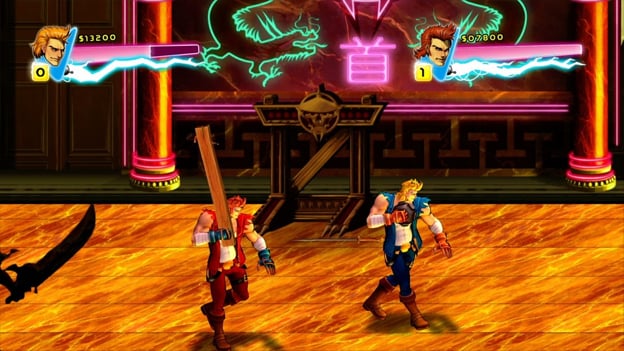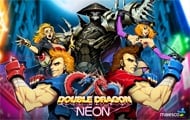Easy To Pick Up And Punch
Video game reboots and remakes have carved themselves a nice little niche in the past few years. And what’s not to get excited about? They rekindle the nostalgia for aging gamers, they are relatively easy for developers to produce, and, when done right, they can make a tidy profit for the publisher, yet still avoid breaking the bank for consumers.
In some respects Double Dragon Neon goes right back to its arcade roots. For a reboot, however, this can be a double-edged sword. Care must be taken to pay respects to the source material while maintaining a current feel. Double Dragon Neon is by no means perfect, but it’s not a disaster either. It fits that comfortable area where it’s fun enough to be worth the modest download price.

The introduction takes us straight back the original game, with Marian (the buxom blonde love interest of our heroes, Billy and Jimmy) getting sucker punched and hauled away by some goons moments before the brothers emerge from a garage. It’s then a casual stroll forward with frequent stops to pound some lackeys into submission. It’s exactly the type of gameplay you may remember: easy to pick up yet challenging to master.
The combat design is the area of the game that takes the most liberties from the brawlers of decades past. It feels old school, but also lacks evolution. You’ve got your light and heavy attacks, jump, grab, and dodge, with combinations between them. For instance, if you connect with a couple of light punches, you can finish with a spin kick using the heavy attack button, or perform a dodge roll behind an enemy and use a sweep attack. You can also run to quickly cover ground or charge an enemy with a shoulder attack. Also returning are the classic weapons, which are found casually lying on the floor, or can be pummeled out of the hands of enemies. Bats, daggers, and whips are few you older gamers may remember, but some new ones have been added to the list (keep an eye out for those hair picks; there are some trophies/achievements gained from them).
The combat mechanics are where the faulty issues are found. The attacks, while satisfying when connected, have a frustratingly small target area. Being a 2D side-scroller in a 3D environment, finding the same plane as your enemy is a tricky endeavor. This concern is heightened with the extremely sluggish animation. There’s enough slowdown that when your attack hits air and the enemy strikes true, you may take out the aggression on your controller.

But the cramped game field itself is what infuriates me the most with this “remake.” I remember Double Dragon I and II using small character sprites in a large area, which made the world feel bigger and gave the series a unique perspective. Developer WayForward’s decision to use large model on a zoomed in area to me is more reminiscent of rival beat ’em up series Final Fight and Streets of Rage, and it doesn’t do justice to the Double Dragon brand.
Some additional elements give Double Dragon Neon a little more substance for today’s feature-craving audience. Besides the standard attacks mentioned above, songs (randomly dropped from enemies or purchased at the Curio Shop) bestow stat-boosting Stances or Sosetsitsu Magic attack powers. These songs can be leveled up for greater effect. Initially they can be upgraded to level ten, but after acquiring Mythril (dropped from bosses) they can be forged at the Tapesmith and eventually be maxed out to level fifty. MP is required to perform magic attacks, which replenishes slowly over time or instantly by picking up batteries. Soda is the health-refilling pickup, and cash is another new collectible, used to purchase items and songs.

You can only have one Sosetsitsu and one Stance active at a time, but they can easily be swapped out. I didn’t think much of this feature at first, but when I realized that the game’s difficulty was as challenging as those old quarter-sucking arcade brawlers, changing songs on the fly quickly became a worthwhile strategy. For example, when attacking enemies across a pit I would use my Fireball for ranged damage, but when in tight quarters against multiple foes, I’d switch to my Spin Kick and take them all out at the same time.
Many of the Stances do more than just boost stats. One of my frequently used tactics was to start with the Successive Strikes Stance, which boosts my attack with each uncontested hit, but when my health fell below 50%, I’d switch to the Desperation Stance, which significantly increases damage output when HP is low. There’s enough of a variety between the Sosetsitsu and Stances that any gamer’s play style can be complimented.
The songs come in the form of vintage cassette tapes, but everything else about Double Dragon Neon just screams 1980s. The scantily clad enemy “dudettes” wear leg-warmers, Billy and Jimmy wail on an air guitar at the end of each stage, and, of course, neon is absolutely everywhere. I love the 80s, so I have absolutely no complaints with this design choice.
I am a little more critical, however, with how the graphics were handled. My biggest complaint is with the character models. Like I mentioned earlier, the size ratio doesn’t feel authentic to the series, and the aesthetic is over-stylized, again more like other brawler games of the era than a true Double Dragon game. The animations are smooth enough, but the backdrops are rigid and clunky. Sure, it feels nostalgic, but it’s underwhelming nonetheless. When you look at a series reboot like Rayman: Origins and how pristine its visuals are, there’s certainly room for Double Dragon Neon to show modern detailing while still feeling retro.

The selection of music is vast, with each Sosesitsu and Stance song having its own track. They’re all original, but all definitely pulled from 80s artists (I’m particular fond of the track that pays homage to Depeche Mode). The background music during gameplay is a mix of electric guitars and synthesizers, which thankfully isn’t too overbearing, but also isn’t memorable. The voice acting is full of the surfer lingo of the era, mixed with extra-cheesy one-liners. Even the main badass, Skullmageddon, dishes out lame taunts with a high tone that is a carbon copy of He-Man’s Skeletor.
I have to admit I was quite deflated when I found out the drop-in/drop-out online multiplayer was absent at launch. “Bromancing” together against waves of enemies was a highlight of the original, and while there’s still two-player local co-op, I was really hoping to knee-smash some heads with strangers. It may be a solid inclusion when it rears its head, but not having online co-op ready at launch tells me some publishing executives wanted to kick the game out the door and turn a profit before it was completely ready.
Hopefully Double Dragon Neon hasn’t given you high expectations, because it doesn’t raise any sort of bar for the reemerging beat ’em up genre. It won’t be the time stealer that the series’ pioneer was. Nevertheless, despite simple game mechanics, the game is not shallow by any stretch, and the difficulty is a refreshing tribute to the classic challenge of old that doesn’t coddle us with checkpoints and infinite lives. The controls are not refined, but it’s nostalgic, engaging, and worth the ten-dollar asking price.
RATING OUT OF 5 RATING DESCRIPTION 3.0 Graphics
Apart from overt pixelation, the visual design screams old school. I think it could have looked a lot better though. 3.4 Control
Combat is easy to pick up and tough to master, but the animations are slow and the target area slim. 4.2 Music / Sound FX / Voice Acting
The diversity of the Sosesitsu and Stance songs has me sitting in the menu screen bopping my head. The rest of the music is passable, and the voice acting hilariously cheesy. 3.5 Play Value
It’s not terribly long, but fun and challenging enough that you’ll want to test your skill on the harder difficulties once you’ve unlocked them. 3.6 Overall Rating – Good
Not an average. See Rating legend below for a final score breakdown.
| Review Rating Legend | |||
|---|---|---|---|
| 0.1 – 1.9 = Avoid | 2.5 – 2.9 = Average | 3.5 – 3.9 = Good | 4.5 – 4.9 = Must Buy |
| 2.0 – 2.4 = Poor | 3.0 – 3.4 = Fair | 4.0 – 4.4 = Great | 5.0 = The Best |
Game Features:
